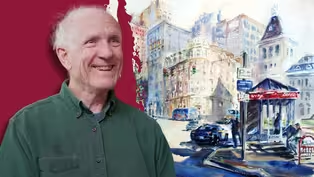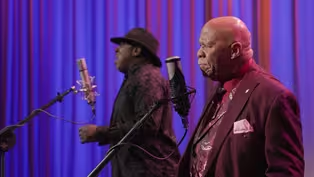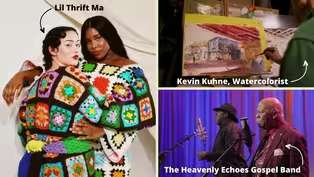
Body Positivity in Fashion: The Art of Lil Thrift Ma
Clip: Season 9 Episode 17 | 10m 16sVideo has Closed Captions
See how Jammella Anderson transforms thrifted textiles into body-positive fashion pieces.
Discover how Jammella Anderson, the creative mind behind Lil Thrift Ma, transforms thrifted textiles into stunning, body-positive fashion pieces.
Problems playing video? | Closed Captioning Feedback
Problems playing video? | Closed Captioning Feedback
AHA! A House for Arts is a local public television program presented by WMHT
Support provided by the New York State Council on the Arts (NYSCA), M&T Bank, the Leo Cox Beach Philanthropic Foundation, and is also provided by contributors to the WMHT Venture...

Body Positivity in Fashion: The Art of Lil Thrift Ma
Clip: Season 9 Episode 17 | 10m 16sVideo has Closed Captions
Discover how Jammella Anderson, the creative mind behind Lil Thrift Ma, transforms thrifted textiles into stunning, body-positive fashion pieces.
Problems playing video? | Closed Captioning Feedback
How to Watch AHA! A House for Arts
AHA! A House for Arts is available to stream on pbs.org and the free PBS App, available on iPhone, Apple TV, Android TV, Android smartphones, Amazon Fire TV, Amazon Fire Tablet, Roku, Samsung Smart TV, and Vizio.
Providing Support for PBS.org
Learn Moreabout PBS online sponsorship- Welcome Jammella to House for Art.
So super happy to have you here today.
- I'm so happy to be here.
- Yay.
So to begin, I wanna let the audience know a little bit about what your creative focus is right now.
- Oh gosh, I feel like my creative focus is like, 10 different things, but I would say that number one is like making clothes for people with all different types of bodies and trying to like not be, like sort of fit into what the norm is and to be like exploratory and to be creative with like the colors and the patterns and the shapes of things.
And really like try and inhabit what art means, but in clothing form.
- Okay, so you focus more on like garments and textiles and fabric?
- Yeah, well reusing garments, breaking things apart, using old blankets, kind of like what I'm wearing right now.
And, like, reinventing or reimagining what the textiles are, giving them new life again.
- Oh, I love that.
So with this, why is this type of mending or reworking important within the current fashion industry?
Because you're pretty much taking secondhand clothes or materials and reworking it to be something new.
- Mhm.
- And, you know, the fashion culture right now isn't really like that currently.
So I want to, like, get your perspective on why that is important in today's culture.
- Yeah I, one of the most shocking things that I think I've heard is that the fashion industry is like number two in terms of pollution in the world.
And the way that we get our clothing and the water usage and the labor and the, like, you know, child labor, all the like really horrible things that you hear about every industry really, is so prevalent in the fashion industry.
And so with reworking or some people call up cycling, we're eliminating so much of that.
So instead of sending things to the landfill, instead of letting things kind of go to die, we're like giving them new life, you know?
That's exactly how we wanna put it.
And fast fashion, you know, I don't wanna knock anybody 'cause fast fashion does give us the opportunity to feel good in clothing, to stay kind of on the trends.
But when it comes to like, not trying to pollute the earth and be more sustainable, it's just, it's not the way.
But I think that what's super important is to kind of mix the two together.
So how can you kind of go in one direction, maybe get something that is a little bit more cheap, but how do you use it more?
How do you get more life out of it?
And that's where I think mending comes in.
It's not just mending vintage clothing.
It's not just mending old clothing.
It's mending things that you already have.
And so okay yeah, you got a hole in your sweater.
Maybe it's from H and M, but if you can learn how to preserve it, it'll last way longer.
- Yeah, and why do you think that's important?
- I think it's important because again, it stops pollution, but also like it allows clothing to be more of an art type.
So like mending can be more than just making it look like it once did.
It could be adding patches, it could be adding new color, it could be actually making it fit you better.
Because obviously the fashion industry makes clothing for one type of body and so if we can mend our clothing or like learn how to like rework it to fit us, then it is specifically for us.
And like how good does it feel to wear something that's just for you?
- Exactly.
You're literally wearing your own piece of art.
- Yeah.
- So let's talk about Lil Thrift Ma.
So what is Lil Thrift Ma?
Give us some background.
- Lil Thrift Ma is something that I didn't mean to start.
I just really like to shop.
I like to shop for other people.
I love to give gifts and it's sort of like, it was like a natural snowball.
My partner got me a sewing machine and so I was like starting to find clothes in the thrift store and again, mending them, trying to, you know, make this fit my body, my shape and then I was like I would love to do this for other people.
And it sort of, like, just really took off from there.
So I have a vintage shop.
I mostly focus on vintage from the '80s and '90s, little bit of Y2K, and then of course I'm doing like adjacent to that, all the stuff that I rework.
So getting blankets and denim and just secondhand fabrics and bringing both of those worlds together.
- Why '70s and '80s?
- '70s, '80s, and '90s, well, I think I'm really inspired by my grandparents and my mom.
My grandma had this like, she like, I didn't even think about it, but I'm wearing leopard print today and my grandma always wore it.
So for me, even just seeing that pattern is like really nostalgic and it brings me so much joy.
And like, I think that her style was just so classic, but also like really wild.
And so those eras that I focus on are really like, you know, attributing that.
She passed away many years ago so for me it feels like I'm kind of like, involving her in the process even though she's not here.
- Yeah, that's beautiful.
And that those clothes are built to last as well.
You know, I think we all have the, well at least one blanket from our great-grandmother.
You know, hopefully we all do in each of our households.
- Yeah.
- So you were recently featured in Glamour Magazine, congratulations.
- Thank you.
- About reinventing the art of knitwear and knitting and crocheting.
So give us some examples how you've done that within your practice.
- Yeah, so I think that because of that again, that like generational inspiration behind reworking clothes, especially reinventing knitwear, which I was actually approached for the article because they thought that I was the one crocheting everything, and I don't take credit for that, but I do like to say that the clothing was handmade twice.
And so I think that quote was actually in the magazine.
So I'm taking blankets that are often like disregarded and a lot of times I'll find like, grandma's names stitched into the blankets and things.
And so taking the blankets, kind of chopping 'em up, making pants, shirts, hats, stockings, whatever.
That's really what that article kind of focused on.
Like how are we taking this sort of thing that we see as for older people and reinventing it for young people, making it a part of our wardrobe and like really passing down the art of crocheting, the art of reworking, sewing, all of those things, mending?
And how it doesn't have to be just for older generations, that we should keep it going through our lineage and how important it is 'cause it is another way to preserve.
- It really is.
It truly is another way to preserve, again, beautiful articles of clothing, which can truly be pieces of art.
So I know you're also featured in Shop Berriez, or was it modeling, what was it with Shop Berriez exactly?
- It was a collaboration, and Emma Zack that runs Shop Berriez, asked me to bring some of my items.
She like handpicked from the stuff I had made to be a part of this photoshoot.
- And I know Shop Berriez really focuses on bodies with curves and different body types.
And I know you briefly discussed that at the beginning of the interview, but I wanna know a little bit more about that mission and truly why, why this intimate connection with that goal?
- Yeah, thank you.
I think like that's really the main point of what I want to do and what I want people to see is that I make clothing for all bodies.
And that means, you know, a lot of times when you walk into the store, you know, we've all worked a mall job and I remember just like not having a size for people that walked into the store and how isolating and how harmful can that be to someone where like, you know, the average size in America is a size 16, 18.
That is definitely not ever reflected in media.
It's never reflected on TV.
And it's like this taboo thing that we have bodies and that we have shapes.
And so what I really seek to do with my clothing is to make it for all bodies, body shapes, and Shop Berriez is like a big inspiration to me because they really have figured out how to curate that.
And so it's something that I really hold true and I don't carry under a certain size and I just want people to come into my shop, my little popups, and to like really feel seen.
It's like so life-changing for people when they walk up to my booth and they say wow, like, this is for me.
I never go to vintage markets or thrift stores.
I never find stuff for me.
And they're always told that well people weren't that size back then.
And that's not true.
It's really not.
People are all sizes at all times.
And so to hear that is like, really just like solidifying what I do.
And then again calling back to my grandma, she was a plus size woman and like, she's so beautiful as all people are.
And so just really, again, attributing it back to her and to like make sure that people feel as good as she looked and as as good as she felt when she was younger.
- That's true, and that's what clothes should do.
You know, we put on clothes to flex, to peacock, to look good, to feel good in our own skin.
- Why like take part of your, why dampen your personality, why dampen yourself and make yourself quiet?
Like your clothes should be an expression of you, who you are, and it's like, it's so important.
It's like a huge part of who we are.
- It really is and thank you for like providing that space and opportunity for folks out there.
I know it's definitely appreciated.
So any future artistic endeavors that involve mending or reworking that you see in your future?
Or any collaborations you want to just like dive into?
- Yeah I, I really want to start figuring out a way to create art pieces with my work.
So like beyond the art pieces of clothing, but finding out ways, making statements with art and there's so much waste.
Even after we've like, used all of the fabric we can from the blankets or the secondhand materials, there's still this like waste aspect and a lot of people do like pillows and things and they'll stuff it with like the bits of the blankets that they cut off.
So I wanna find a way to like really start to use like every single piece of the fabric.
And then I'd love to collab with other people.
I wanna collab with artists that paint, do screen printing.
I wanna bring like mixed media to the art and wear it.
So figuring out how to do that and how to make it for everyone.
- Yeah, it's amazing.
You heard it guys, like hit Jammella up if you want to collab.
Well thank you Jammella for stopping by today and talking with us.
I appreciate it.
- Thank you.
Discovering Albany's Urban Beauty with Kevin Kuhne
Video has Closed Captions
Clip: S9 Ep17 | 7m 47s | Explore watercolorist Kevin Kuhne's local urban landscapes. (7m 47s)
The Heavenly Echoes Gospel Band Performs "Testify"
Video has Closed Captions
Clip: S9 Ep17 | 5m 31s | "Testify" with The Heavenly Echoes Gospel Band. (5m 31s)
Watercolor Wonders, Fashion Transformations, & Gospel Inspirations: Preview
Video has Closed Captions
Preview: S9 Ep17 | 30s | Discover watercolor techniques, fashion reinventions & a soul-stirring gospel performance. (30s)
Providing Support for PBS.org
Learn Moreabout PBS online sponsorshipSupport for PBS provided by:
AHA! A House for Arts is a local public television program presented by WMHT
Support provided by the New York State Council on the Arts (NYSCA), M&T Bank, the Leo Cox Beach Philanthropic Foundation, and is also provided by contributors to the WMHT Venture...


















